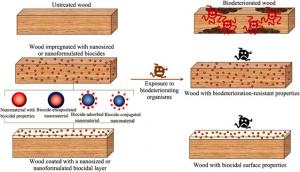
Nanotechnology approaches towards biodeterioration-resistant wood
Published in Journal of Bioresources and Bioproducts
NANJING, CHINA, May 11, 2024 /EINPresswire.com/ -- Emerging technologies such as nanotechnology can provide efficient approaches by which new materials with broad functions such as durable and fire-retardant properties, can be developed and subsequently used for the treatment of wood materials. In a study published in the KeAi journal “Journal of Bioresources and Bioproducts”, an international team from New Zealand (Scion) and China (Northeast Forestry University) report a review that nanotechnology-based methods can be employed to mitigate these weaknesses and create durable, sustainable wood materials (as shown in the image).These wood nanotechnologies also can be employed to develop wood products with antimicrobial surfaces for various applications. Furthermore, analytical tools used in nanoscience and nanotechnology enable the precise study of wood structure and its components on a nanometre scale, particularly those aspects that can affect wood products' biodeterioration resistance properties. A great deal of advancement has been achieved in the performance of these analytical tools in recent years. However, even further information on underpinning mechanisms of the biodurability of wood materials can be obtained by employing the pertaining techniques in the study of physical and chemical characteristics of wood components as well as the interaction between bio-organisms and wood components in nanometre and molecular levels.
In this review, they present brief information about wood biodecay organisms and a short explanation of the fundamental mechanisms underpinning the biodecay phenomena. In continue, conventional methods used for the wood treatment to inhibit wood biodecay, and the challenges that these methods usually deal with are briefly described. Then, in more detail, recent trends in the field of application of nanotechnology-based approaches for the development of wood products with biodeterioration-resistant properties are comprehensively reviewed. Furthermore, nanotechnology-based methods that have been employed to enhance some other properties of wood materials such as hydrophobicity, dimensional stability, mechanical strength, etc., and simultaneously have shown indirect positive effects on the biodeterioration resistance properties of the resultant wood products are discussed too.
Finally, a future outlook is also provided. The life cycle assessment of the novel nanostructured wood products will provide a holistic understanding of the environmental implications and safety considerations associated with these products and their manufacturing and end-of-life processes. This endeavour paves the way for the efficient application of nanotechnology-based methods for industrial manufacturing and the widespread application of biodeterioration-resistant wood materials.
DOI
https://doi.org/10.1016/j.jobab.2023.09.001
Original Source URL
https://www.sciencedirect.com/science/article/pii/S2369969823000555
Journal of Bioresources and Bioproducts
Nanjing Forestry University
02585426289
email us here
EIN Presswire does not exercise editorial control over third-party content provided, uploaded, published, or distributed by users of EIN Presswire. We are a distributor, not a publisher, of 3rd party content. Such content may contain the views, opinions, statements, offers, and other material of the respective users, suppliers, participants, or authors.


